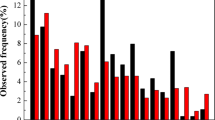Abstract
A giant magnetoimpedance (GMI)-based biosensor was developed for detection of Escherichia coli (E. coli) O157: H7. The GMI sensor involving the sensing elements of Cr/Cu/NiFe/Cu/NiFe was fabricated by Micro Electro-Mechanical system (MEMS) technology, including thick photoresist lithography and electroplating. A separate Au film substrate as immunoplatform was used to capture E. coli O157:H7. The monoclonal mouse anti-E. coli antibody was immobilized on Au film substrate surface with a self-assembled layer. The different concentration E. coli O157:H7 (100, 300 and 500 cfu/ml) were combined with Dynabeads-antibody conjugates (DAC) respectively. DAC were prepared by conjugating streptavidin-coupled Dynabeads with biotin-labeled polyclonal mouse anti-E. coli antibodies. The classical sandwich assay was used for detection of E. coli O157:H7 targeted with Dynabeads by using antibody-antigen pair combination of biotin-streptavidin. The fundamental principle for detection of E. coli O157:H7 based on GMI sensor was that Dynabeads were employed as magnetic labels of E. coli O157:H7, and E. coli O157:H7 can be monitored by detecting the fringe field of Dynabeads using magnetic sensing elements. We observed that the GMI ratio were significantly improved due to the presence of E. coli O157:H7 combined with Dynabeads. The GMI ratio increased as the E. coli O157:H7 concentration increased. A lower detectable concentration of 100 cfu/ml was achieved in present work. The GMI-based biosensor provides a new method to rapid and sensitive detection E. coli O157:H7, which has a large potential for bio-application.









Similar content being viewed by others
References
F. Alves, L. Abi Rached, J. Moutoussamy, C. Coillot, Sens. Actuators A 142, 459 (2008)
F.E. Atalay, H. Kaya, S. Atalay, J. Phys. D, Appl. Phys. 39, 431 (2006)
C. Berggren, B. Bjarnason, G. Johansson, Biosens. Bioelectron. 13, 1061–1068 (1998)
R.L. Bunchnan, M.P. Dolye, Food Technol. 51, 69–76 (1997)
Centers for Disease Control and Prevention (CDC), 2005. Disease Information-E. coli O157:H7. Available at: www.cdc.gov. Accessed December.
L. Chen, Y. Zhou, Z.M. Zhou, W. Ding, J. Phys. D. Appl. Phys. 42, 145005 (2009)
L. Chen, C.C. Bao, H. Yang, C. Lei, Y. Zhou, D.X. Cui, Biosens. Bioelectron. 26, 3246–3253 (2011)
D.R. Demarco, E.W. Saaski, D.A. McCare, D.V. Lim, J. Food Prot. 62, 711–716 (1999)
J. Devkota, A. Ruiz, P. Mukherjee, H. Srikanth, M.H. Phan, IEEE Trans. Magn. 49, 4060 (2013)
K.S. Gracias, J.L. McKillip, J. Can, Microbiol. 50, 883–890 (2004)
J.L. Guesdon, S. Avrameas, Magnetic solid phase enzymeimmunoassay. Immunochemistry 14, 443–447 (1977)
B.-I. Haukanes, C. Kvam, Application of magnetic beads in bioassays. Biohechnol. 12, 60–63 (1993)
S.S. Iqbal, W.M. Mayo, J.G. Bruno, B.V. Bronk, C.A. Batt, J.P. Chambers, Biosens. Bioelectron. 15, 549–578 (2000)
P. Irwin, W. Damert, J. Berwater, A. Gehring, S.-I. Tu, J. Rapid Meth, Autom. Microbiol. 10, 129–147 (2002)
D. Ivniski, I. Abdel-Hamid, P. Atanasov, E. Wilkins, Biosens. Bioelectron. 14, 599–624 (1999)
G.V. Kurlyandskaya, M.L. Sanchez, B. Hernando, V.M. Prida, P. Gorria, M. Tejedor, Appl. Phys. Lett. 82, 3053–3055 (2003)
D.P. Makhnovskiy, L.V. Panina, Sens. Actuators A 81, 91 (2000)
V. E. Makhotkina, B. P. Shurukhina, V. A. Lopatina, P. Yu. Marchukova, Yu. K. Levina, Sens. actuators A 25–27, 759 (1991).
C.S. Mayo, R.B.J. Hallock, Immunol. Methods. 120, 105–114 (1989)
S. Oh, M. Jadhav, J. Lim, V. Reddy, C. Kim, Biosens. Bioelectron. 41, 758–763 (2013)
L.V. Panina, K. Mohri, Appl. Phys. Lett. 65, 1189 (1994)
M.H. Phan, H.X. Peng, M.R. Wisnom, S.C. Yu, N.H. Nghi, C.G. Kim, Sens. Actuators A 129, 62 (2006)
C.A. Phillips, J. Sci. Food Agric. 79, 1367–1381 (1999)
C. Ruan, L. Yang, Y. Li, Anal. Chem. 74, 4814–4820 (2002)
T.M. Silk, C.W.J. Donnelly, Food Protection 60, 1483–1486 (1997)
P.D. Skottrup, M. Nicolaisen, A.F. Justesen, Biosens. Bioelectron. 24, 339–348 (2008)
R.L. Sommer, C.L. Chine, Appl. Phys. Lett. 47, 3346 (1995)
T.C. Tang, A.P. Deng, H.J. Huang, Anal. Chem. 74, 2617–2621 (2002)
S.-I. Tu, M. Golden, P. Andreotti, L.S.L. Yu, P. Irwin, J. Rapid Meth, Autom. Microbiol. 9, 71–84 (2001)
S.-I. Tu, J. Uknalis, M. Gore, P. Irwin, I. Feder, J. Rapid Meth, Autom. Microbiol. 11, 35–46 (2003)
S.-I. Tu, S. Reed, A. Gehring, Y. He, G. Paoli, Sensors 9, 717–730 (2009)
M. Varshney, Y. Li, B. Srinivasan, S. Tung, Sens. Actuators B. 128, 99–107 (2007)
M. Vázquez, M. Knobel, M.L. Sánchez, Sens. Actuators A 159, 20–29 (1997)
J. Wang, P.V.A. Pamidi, K.R. Rogers, Anal. Chem. 70, 1171–1175 (1998)
T. Wang, C. Lei, J. Lei, Z. Yang, Y. Zhou, Appl. Phys. A 109, 205–211 (2012)
T. Wang, Y. Zhou, C. Lei, J. Lei, Z. Yang, Sens. Actuators B 186, 727–733 (2013)
T. Wang, Z. Yang, C. Lei, J. Lei, Y. Zhou, Biosens. Bioelectron. 58, 338–344 (2014a)
T. Wang, Z. Yang, C. Lei, J. Lei, Y. Zhou, J. Appl. Phys. 115, 223901 (2014b)
T. Wink, S.J. Van Zuilen, A. Bult, W.P. Van Bennekom, Anal. Chem. 70, 827–832 (1998)
A. Wolter, R. Niessner, M. Seidel, Anal. Chem. 80, 5854–5863 (2008)
L. Yang, R. Bashir, Biotechnol. Adv. 26, 135–150 (2008)
L.S.L. Yu, J. Uknalis, S.J. Tu, Immunol. Methods. 256, 11–18 (2001)
Y. Zhou, J.Q. Yu, X.L. Zhao, B.C. Cai, J. Appl. Phys. 89, 1961 (2001)
Acknowledgments
This work was supported by The National Natural Science Foundation of China (No. 61074168 and No. 61273065), National Science and Technology Support Program (2012BAK08B05) and National Key Laboratory Research Fund (9140C790403110C7905). Natural Science Foundation of Shanghai (13ZR1420800) and the Analytical and Testing Center in Shanghai Jiao Tong University.
Author information
Authors and Affiliations
Corresponding authors
Rights and permissions
About this article
Cite this article
Yang, Z., Sun, Xc., Wang, T. et al. A giant magnetoimpedance-based biosensor for sensitive detection of Escherichia coli O157:H7. Biomed Microdevices 17, 5 (2015). https://doi.org/10.1007/s10544-014-9925-6
Published:
DOI: https://doi.org/10.1007/s10544-014-9925-6




